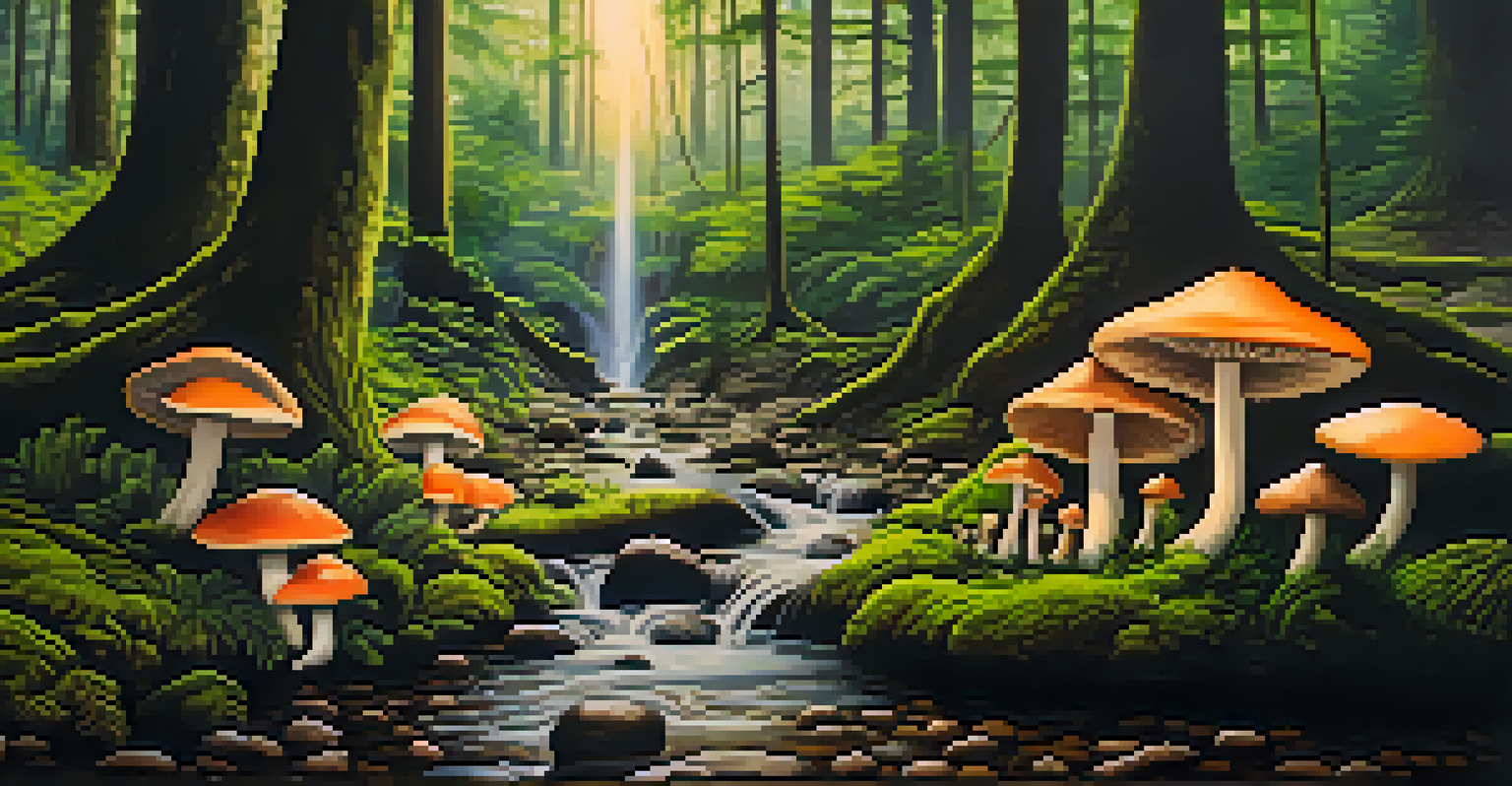The Role of Entheogens in Shaping Environmental Values

Understanding Entheogens: A Brief Overview
Entheogens are substances that are often used in spiritual or religious contexts to enhance consciousness. These can include plants, fungi, or synthetic compounds that alter perception and promote introspection. By tapping into altered states of consciousness, users often report profound experiences that can reshape their views on life and the environment.
Nature does not hurry, yet everything is accomplished.
Many cultures have utilized entheogens for centuries, seeing them as a bridge between the physical world and spiritual realms. For instance, indigenous communities in the Amazon have long used ayahuasca in their rituals, fostering a deep connection to the rainforest. This connection often translates into a strong environmental ethic, emphasizing the importance of preserving the natural world.
As society becomes more aware of ecological issues, understanding the role of entheogens in cultivating environmental values is crucial. By examining personal experiences and collective narratives surrounding these substances, we can glean insights into how they might inspire a more profound respect for nature.
The Historical Context of Entheogens and Nature
Throughout history, various cultures have intertwined their use of entheogens with their environmental practices. For example, the Native American Church uses peyote in ceremonies that emphasize gratitude for nature's gifts. This spiritual connection reinforces a sense of responsibility towards the land and its preservation.

In ancient civilizations, such as the Aztecs and Mayans, entheogens were often integral to rituals aimed at honoring the earth. These practices not only provided spiritual insights but also fostered communal values centered around sustainability and reverence for nature. Such historical precedents highlight the long-standing relationship between altered states of consciousness and environmental stewardship.
Entheogens Enhance Nature Connection
Entheogens can promote feelings of interconnectedness with nature, inspiring individuals to adopt more environmentally conscious behaviors.
Understanding these historical contexts can help modern individuals appreciate the wisdom embedded in these traditions. It encourages a re-evaluation of how we perceive our relationship with nature, reminding us that many societies have long recognized the importance of living in harmony with the environment.
Personal Experiences: Transformation Through Entheogens
Many individuals who have used entheogens report transformative experiences that reshape their environmental values. These journeys often lead to a heightened awareness of interconnectedness with all living beings. For instance, someone might emerge from an experience with psilocybin mushrooms feeling an overwhelming urge to advocate for conservation efforts.
The Earth has music for those who listen.
These personal narratives illustrate how entheogens can act as catalysts for change, igniting passion for protecting the environment. Participants often describe feelings of unity with nature, fostering a sense of responsibility towards ecological health. Such transformations can inspire individuals to engage in environmental activism or adopt sustainable lifestyles.
Moreover, these experiences can create lasting shifts in perspective, making the importance of environmental values more palpable. By sharing these stories, we can encourage others to explore their own connections to nature and consider how entheogens might play a role in that journey.
Scientific Research on Entheogens and Nature Connection
Recent scientific studies have begun to explore the relationship between entheogens and environmental values. Research indicates that substances like psilocybin can enhance feelings of connectedness to nature, which may lead to more environmentally conscious behaviors. This growing body of evidence highlights the potential for these substances to positively impact our relationship with the earth.
For example, a study found that participants who experienced nature-related mystical experiences while under the influence of psilocybin reported increased ecological concern. This correlation suggests that entheogens may provide a unique avenue for fostering environmental awareness. By understanding the mechanisms behind these experiences, we can better comprehend their implications for environmental values.
Entheogens Enhance Nature Connection
Substances like psilocybin can foster feelings of connectedness to nature, potentially leading to more environmentally conscious behaviors.
As science continues to unravel the effects of entheogens on consciousness, it opens up possibilities for integrating these insights into environmental education. By bridging the gap between personal experience and scientific research, we can create a more comprehensive understanding of how entheogens can shape our values toward the environment.
Cultural Movements: Reviving Ancient Practices
In recent years, there has been a resurgence of interest in the cultural practices surrounding entheogens. Many modern movements aim to revive ancient traditions that emphasize the interconnectedness of all life. By looking back to these practices, contemporary society can glean insights into how to align our values with environmental sustainability.
Cultural movements such as the neo-shamanism trend focus on integrating traditional wisdom with modern ecological consciousness. Participants often engage in ceremonies that honor nature, promoting values of respect and stewardship. This revival can help foster a deeper appreciation for the earth and inspire collective action towards its preservation.
By marrying ancient practices with contemporary environmental challenges, we can create a more holistic approach to sustainability. This fusion of old and new perspectives can empower individuals and communities to take meaningful action in protecting our planet.
Challenges and Misconceptions Surrounding Entheogens
Despite the potential benefits of entheogens in shaping environmental values, there are challenges and misconceptions that must be addressed. Stigmas surrounding these substances often lead to misunderstandings about their use and effects. This stigma can prevent individuals from exploring how entheogens might foster deeper connections to the environment.
Moreover, there is a risk of appropriating indigenous practices without understanding their cultural significance. It’s crucial to approach the use of entheogens with respect and awareness of their historical contexts. This means engaging with and learning from the cultures that have long revered these substances rather than exploiting them for personal gain.
Cultural Practices Revive Sustainability
Modern movements are reviving ancient traditions that emphasize the interconnectedness of all life, promoting environmental stewardship.
Addressing these challenges requires open dialogue and education. By fostering a more nuanced understanding of entheogens, we can create a supportive environment that encourages exploration while respecting the traditions that have shaped their use.
Looking Ahead: Entheogens and Environmental Activism
As we move forward, the potential for entheogens to influence environmental activism is both exciting and promising. With increasing awareness of the ecological crisis, individuals are seeking new ways to connect with nature and inspire action. Entheogens can serve as powerful tools for unlocking deeper environmental awareness and commitment.
Activists and organizations are beginning to incorporate entheogenic experiences into their strategies for mobilizing support. By creating spaces for people to explore their relationship with nature through these substances, they can nurture a sense of urgency and purpose. This approach can lead to innovative solutions for addressing environmental challenges.

Ultimately, the integration of entheogens into environmental activism could lead to a more empathetic and engaged populace. As more people explore these altered states of consciousness, we may witness a shift in values that prioritizes the well-being of our planet and its ecosystems.